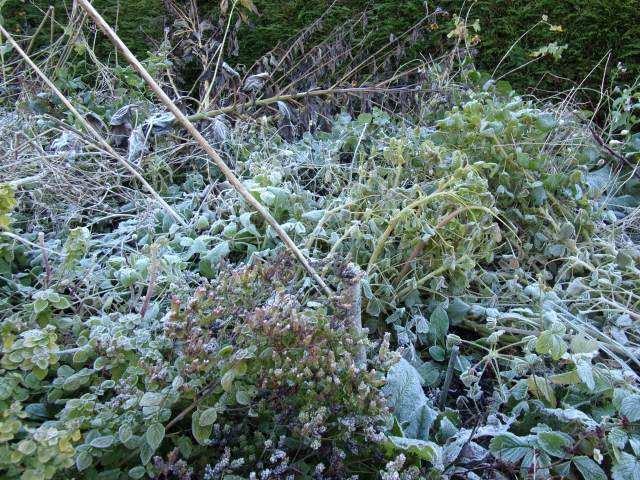From the outset a forest garden is designed as a natural system. We provide the physical structure – various edible trees, climbers, shrubs, herbaceous perennials and some annuals – to make the best use of the physical space and ensure a diversity of plants for the various needs of an ecosystem. After that it is largely up to nature to work her magic. Diversity ensures health, an abundance of biomass which is allowed to compost naturally back into the soil ensures increasing fertility. Allowing plants to flower and set seed calls forth new generations and fills gaps and nature adds her own plants in from the wind or from the seedbank of the generations before that is sitting in the soil waiting for the opportunity to grow. This enhances diversity and makes the system yet more resilient.
When I began my forest gardening adventure I had in mind to make minimal interventions and let nature have as free a hand as possible. This has continued to be my practice and will remain so. I have quickly looked through photos from 2016 from March to December to illustrate nature’s role as primary gardener – there were hundreds to choose from so here is my selection:

Last summer’s mashua stems covering the ground through the winter – habitat for insects and protection for the soil

Blackbird feasting on ivy berries

Ground cover beneath gooseberry bush, self sown lamb’s lettuce and salsify amidst twiggy debris

Chives, parsley and bugle were planted here, forget me not and dandelion added by nature

Leaf beet, self sown from the previous year’s seed

Tree onions growing very strongly, surrounded by clover, marjoram, land cress, skirret, fennel and with some dead plant material (possibly land cress) feeding the soil behind them.

A forest of fennel – incredible for the bees and hoverflies in summer then the seeds feed blue tits in winter

Sunset apples on a tree which has been in the garden for three years

Daubenton’s kale cutting from the previous year has spread to lean across the lawn and is growing strongly as the autumn approaches.

November now and the frost has come. Plants are bending to the cold but the oca, Jerusalem artichoke and mashua here will give a harvest yet.

December, the garden is sleeping but the structure is in place to provide habitat for wildlife over the winter months and to protect the soil.
And it was also beautiful – largely thanks to the flowers planted by nature:

Salsify flower land cress and forget me not behind

The ‘triangle’ bed

Self sown Californian poppy and self sown vetch

Self sown foxgloves

Yarrow, vetch and fennel

Polyculture edged with nasturtiums and fennel

Jerusalem artichoke in flower
Standing on the cusp of spring 2017 I am so looking forward to what unfolds this year.

Thank you for sharing these plant communities and their larger environs. This is a wonderful inspiration; so many volunteers sprouting all over the place!
LikeLiked by 1 person
The sunchoke flower picture at the bottom is very nice. If it’s alright with you, I’ll copy and post it to my Instagram with credit and link to you.
LikeLike
Of course, feel free! Anni
LikeLike
Thanks Anni! I hope it introduces some new readers to your work.
LikeLiked by 1 person
Hi Anni. Thanks . First newsletter ive had off you in a while !
LikeLike
Hi, Yes I haven’t posted much over the winter. I have been spending time thinking about the garden and the systems it encompasses and looking for a deeper interpretation of what is going on. This may lead a different emphasis in future posts.
LikeLike